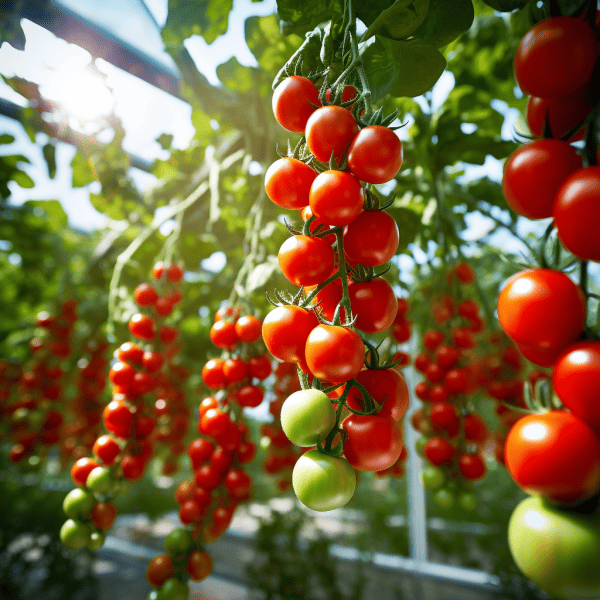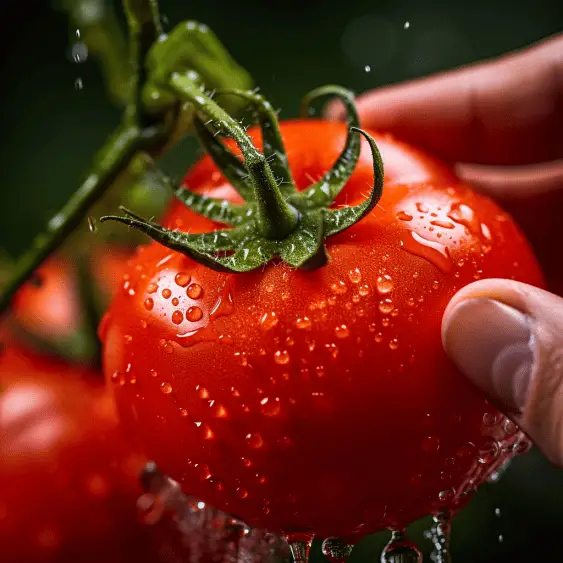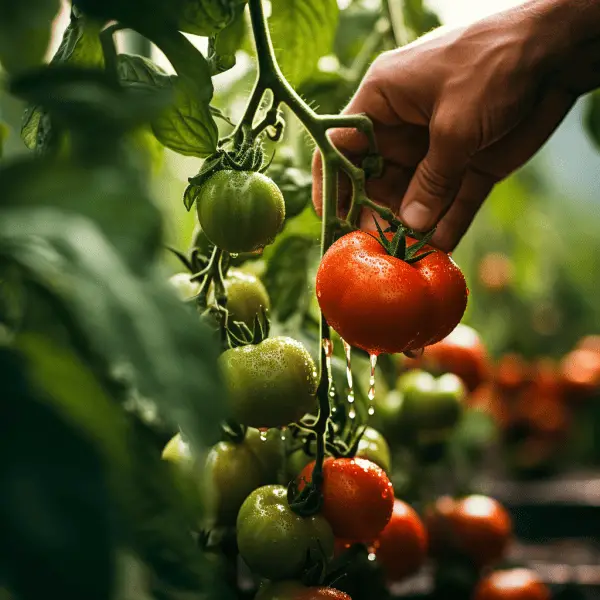Hey tomato lovers! Have you ever thought about growing juicy tomatoes without soil using hydroponics? I’ve been honing my hydro tomato skills for years, and let me tell ya, the results are so rewarding. Homegrown hydroponic tomatoes just burst with flavor!
In this article, I’ll share my top tips to help you succeed with hydroponic plants as tomatoes. From choosing the right varieties to providing proper nutrients, you’ll learn the secrets to bountiful, delicious harvests. Whether you’re starting small with just a few container tomatoes or aiming for a high-yield hydro setup, these tricks will set you up for tomato success!
First up is selecting the best tomato strains for hydro. Look for compact, determinate tomatoes since they stay a manageable size for containers. Trust me, you’ll want varieties like ‘Red Robin’ or ‘Tumbling Tom’. Don’t go with sprawly indeterminate types intended for field growing.
Your nutrient mix is critical too. Tomato plants need constant fertilizer with key macros like nitrogen and calcium.
I’ll explain foolproof fertilizers and how to avoid issues like blossom end rot. Let’s get growing!
KEY TAKEAWAY
What are the tips and tricks for hydroponic tomatoes?
By implementing effective tips and tricks for hydroponic tomatoes (1), you can maximize yields, ensure plant health, and enjoy the satisfaction of growing your own fresh, flavorful tomatoes year-round.
Choosing the Right Hydroponic System for Tomatoes
Hey tomato growers, let’s dive into picking the ideal hydroponic setup for plump, beautiful tomatoes! The system you choose really depends on your goals. Small container gardens are great for starters, while advanced hydroponic setups like deep water culture can support high-yield plant growth.
For just a few container tomatoes, I recommend starting with either the Dutch bucket technique or a simple ebb and flow system. The Dutch bucket method (2) uses 5-10 gallon buckets filled with a growing medium like clay pebbles. An air stone at the base provides oxygen to the roots and a PVC pipe feeds the nutrient solution.
Ebb and flow systems work by temporarily flooding the grow tray with nutrient water before draining. This allows the roots to soak up what they need before getting fresh air. For small-scale growing, ebb and flow offers flexibility.
Now if you’re ready to grow buckets of tomatoes, a deep water culture (DWC) system is ideal. DWC involves suspending the plants above a reservoir of nutrient-rich water. The roots dangle directly into the solution. Highly oxygenated water promotes fast growth!
You could also try vertical hydroponic towers to maximize limited space. Just ensure adequate lighting reaches all plants, and use compact varieties like ‘Tumbling Tom’ in towers. Pick a strategy that aligns with your gardening goals and scale.
Selecting the Best Tomato Varieties for Hydroponics

When choosing tomato varieties for hydroponics, steer clear of sprawling indeterminate types that grow like vines. They’re difficult to tame! Instead opt for bushy determinate tomatoes that stay compact, or “container tomatoes” bred for hydro culture.
Great petite determinate varieties include ‘Red Robin’ – a cherry tomato, ‘Tumbling Tom’ – perfect for hanging baskets, and ‘Mountain Princess’ – an early, heavy yielder.
For full-size tomatoes, try ‘Skyway’ – a productive determinate, ‘Big Beef’ – an ultra meaty hybrid, or ‘Celebrity’ – a disease-resistant favorite. ‘Sunsugar’ is a scrumptious yellow cherry tomato.
Indeterminate tomatoes may produce abundantly but require intense trellising and pruning in hydro systems. Stick to determinate for easier management. And be sure to research disease resistance – hydroponic culture leaves plants more vulnerable to fungi and bacteria. Pick resistant strains!
Providing Optimal Growing Conditions for Hydroponic Tomatoes

To flourish, hydroponic tomato plants need proper conditions. Pay close attention to factors like temperature, lighting, airflow, and more. Let’s go over the ideal environment for hydroponic tomatoes.
Tomatoes thrive in consistently warm conditions between 70-80°F during the day, and 60-70°F at night. Chilling injury occurs below 55°F. Consider a greenhouse or grow lights if ambient temperatures are routinely cool.
Adequate lighting is also crucial. Tomatoes require a minimum of 6 hours direct sun, but 8-12 hours is best. Supplement natural daylight with grow lights like LEDs or high pressure sodium to ensure sufficient intensity.
Good airflow circulates air and strengthens plants. Use oscillating fans to gently blow across seedlings and mature plants. Just avoid harsh blasts directly on the plants.
It’s also key to keep your nutrient reservoir cool – ideally 65-75°F. Warmer water promotes root disease. Install water chillers if needed to prevent reservoirs from overheating.
Meeting these conditions will ensure your hydroponic tomato crop thrives! Paying attention to lighting, stable warm temperatures, gentle airflow, and cool root zones makes all the difference.
Nurturing Tomato Seedlings and Saplings in Hydroponic Systems
Starting tomato seedlings properly gives them the best chance at maturity. Here are my secrets for nurturing strong saplings until they’re ready for your hydro system!
I germinate seeds in moist perlite or vermiculite under grow lights. Keep soilless cubes evenly moist. Once sprouted, move to small net pots suspended over water.
When the first true leaves appear, begin weekly feeding with half strength nutrient mixes. Boost to full strength when additional leaves develop. Let seedlings get 12-18 inches tall before transplanting.
Avoid overwatering which invites rot. Allow cubes to partially dry between waterings. Give plenty of light but keep intensities moderate – seedlings burn easily.
Gradually expose plants to gentle airflow for stronger stems. Use fans sparingly at first. And maintain warm temperatures around 75°F for optimal growth.
With attentive early care, your seedlings will establish hardy root systems and vigorous growth to thrive when transferred into your main hydroponic setup!
Understanding Nutrient Mixes and Fertilizers for Hydroponic Tomatoes
One of the most important factors in hydroponics is getting your nutrient mix right to feed those hungry tomato plants! Commercial blends formulated for hydroponics take the guesswork out of fertilizing.
Look for formulas tailored to fruiting vegetables like tomatoes, peppers and cucumbers. Key macros like nitrogen, phosphorus and potassium should be present along with various micronutrients.
A good starting ratio for tomatoes is 150-200 ppm nitrogen, 40-80 ppm phosphorous, and 150-300 ppm potassium during the seedling and vegetative stages. Once flowering and fruiting, increase phosphorous to 80-150 ppm.
Aside from blended concentrates, I also recommend adding calcium and magnesium supplements to prevent blossom end rot. Foliar sprays applied directly to leaves are easily absorbed.
Test your reservoir’s pH and EC (electrical conductivity) regularly to ensure nutrients are balanced and available. Keep pH between 5.5-7 and EC 1.2 to 2.4 for tomatoes.
With the right fertilizer mix tuned to each growth phase, you’ll grow hearty tomato plants and harvest mouthwatering ripe tomatoes!
Ensuring Adequate Lighting for Successful Tomato Growth
Proper lighting is make-or-break for hydroponic tomato success! Tomatoes crave bright light, especially fruiting varieties. Insufficient light leads to poor growth and low yields.
If growing outdoors, situate containers where they’ll receive full sun for at least 8 hours daily. More is better! Supplement natural light with grow lights as needed to get 14-18 hours of light per day.
For indoor growing, use full spectrum LED or high pressure sodium grow lights. Position LED panels 6-12 inches above plants. For HPS lights, keep bulbs 12-18 inches away to prevent burning.
Seedlings need 16-18 hours under lights per day. As plants mature, aim for at least 12-14 hours of supplemental lighting even for sunny outdoor spots. Light directly influences flowering and fruiting!
Monitor plant signs like spindly stems and weak flowering. If plants seem to be stretching for light, increase duration and intensity. Robust compact growth indicates adequate lighting.
Exploring Different Growing Mediums for Hydroponic Tomatoes
While hydroponics don’t use soil, plants still require support and stability. Different growing mediums provide this anchor for roots along with oxygenation.
Inert mediums like clay pebbles and perlite are common in hydroponics. They provide ample air pockets without impacting pH or adding nutrients. Reusable clay pebbles are a great renewable option.
Coco coir is another popular medium made from coconut husks. It retains some moisture while still allowing air flow. Use coco in containers or directly in grow channels.
For deep water culture, no medium is needed, just nutrient solution. But a thin starter cube helps seeds establish initially before transferring to the reservoir.
Consider your system style, scale, and maintenance preferences when selecting a medium. And remember – whatever you choose, keep it well aerated for thriving hydroponic tomato roots!
Frequently Asked Questions
How long does it take tomatoes to grow hydroponically?
The timeline for hydroponically grown tomatoes can vary based on the variety and growing conditions, but generally they develop faster than in soil. Most hydroponic tomatoes are ready to harvest in 40-65 days from when seedlings are transplanted into the system.
Quick-growing determinate varieties on the small side like ‘Red Robin’ can be ripe even faster in just over 30 days! So you don’t have to wait too long for fresh hydroponic tomatoes. With the right setup, you’ll be enjoying vine-ripened fruits in about 2 months.
Why are my hydroponic tomatoes flowering but not fruiting?
If your tomato plants are blooming but not producing actual tomatoes, lack of adequate pollination is likely the culprit. Flowers must be pollinated to develop into fruits. This normally happens automatically with wind or insects outdoors, but in indoor hydroponic systems you’ll need to manually pollinate.
Use a soft brush or cotton swab to gently dab pollen from the flower stamen onto the stigma. Do this for every bloom, and be sure to supplement with grow lights to energize fruiting. Proper hand pollination should get those flowers turning into juicy tomatoes!
Will hydroponic tomatoes keep producing?
The great thing about hydroponic culture is that you can enjoy fresh tomatoes for months! Determinate varieties will grow, fruit, and slow down in a single crop. But indeterminate types can keep producing all season long with the right care. Prune suckers and older growth to focus energy on new flowers and fruit.
Maintain optimal lighting, nutrients, and conditions. As long as you provide what they need, indeterminate hydro tomatoes will keep pumping out ripe tomatoes! Expect harvests for 4-6 months or more.
Conclusion
With the right tomato varieties, nutrients, lighting, and care, I hope you’re feeling pumped to try your hand at hydroponic tomatoes! Start small with a container setup to get the basics down. Once you taste that homegrown flavor, you’ll be hooked.
Be sure to share any of your own hydro tips in the comments! Nothing beats the community of fellow tomato enthusiasts. And if you found these tricks useful for your first hydroponic tomatoes, spread the word to help others get growing tomatoes.
The world needs more crispy, vibrant tomato goodness. So what are you waiting for? Grab those seeds and get planting your own little hydro tomato patch.
Just follow these strategies and you’ll be harvesting armloads of juicy red tomatoes in no time. Grow on!
References
- https://igworks.com/blogs/growing-guides/growing-hydroponic-tomatoes-in-your-iharvest#:~:text=High%20in%20potassium.,once%20weekly%20for%20great%20results.
- https://whyfarmit.com/dutch-bucket/
Related Articles
- https://tophydroponicgarden.com/tomatoes/
- https://tophydroponicgarden.com/cultivating-hydroponic-tomatoes/
- https://tophydroponicgarden.com/hydroponic-plants/
Was this helpful?

Crystal Erickson is an agriculture enthusiast and writer with a passion for sustainable farming practices and community development. Growing up on a family farm in rural Iowa, Crystal developed a love for the land and a deep appreciation for the hard work and dedication required to make a farm successful.
After completing a degree in Agriculture and Environmental Science from Iowa State University, Crystal began her career as an agricultural journalist, covering stories and issues related to modern farming practices, crop management, and livestock production. She quickly established herself as a respected voice in the industry, known for her insightful reporting and thoughtful analysis.
Over the years, Crystal has written for a variety of publications, including Farm Journal, Successful Farming, and Modern Farmer, as well as contributing to several academic journals focused on sustainable agriculture and community development. Her work has been recognized with numerous awards, including the Iowa Farm Bureau’s Young Farmer Achievement Award and the National Association of Farm Broadcasting’s Farm Broadcaster of the Year.


